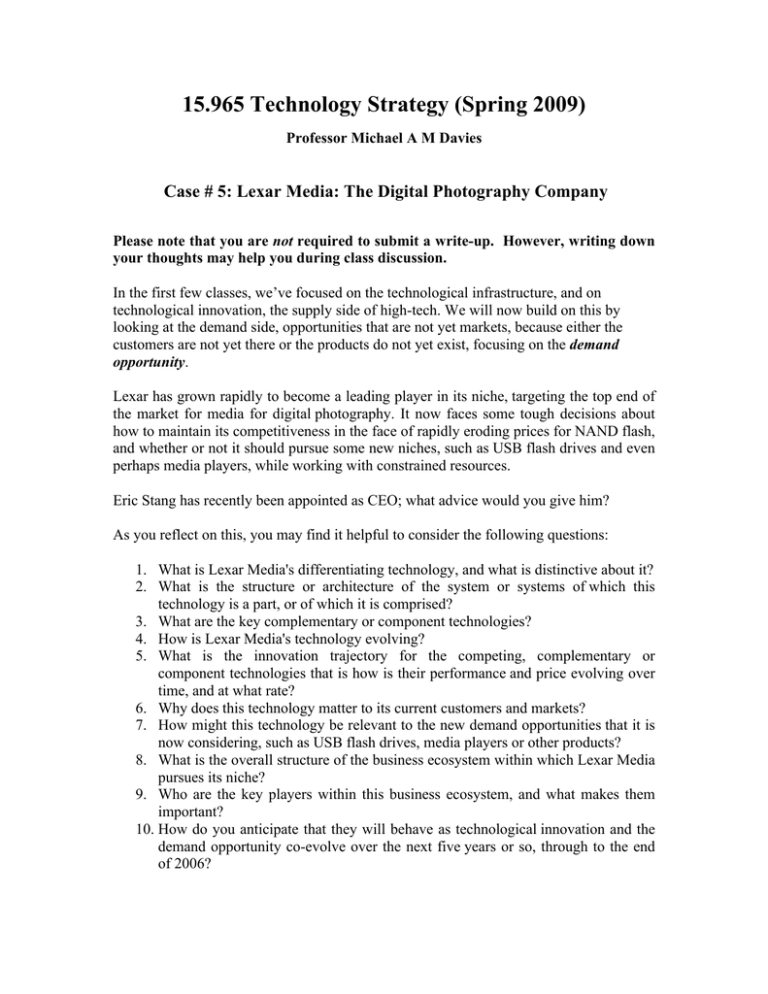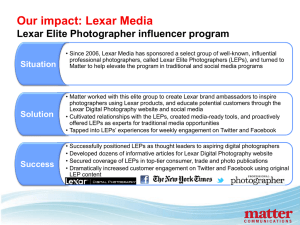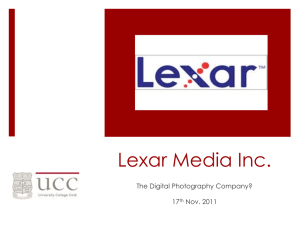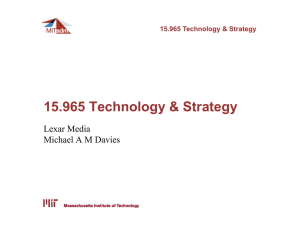15.965 Technology Strategy (Spring 2009)
advertisement

15.965 Technology Strategy (Spring 2009) Professor Michael A M Davies Case # 5: Lexar Media: The Digital Photography Company Please note that you are not required to submit a write-up. However, writing down your thoughts may help you during class discussion. In the first few classes, we’ve focused on the technological infrastructure, and on technological innovation, the supply side of high-tech. We will now build on this by looking at the demand side, opportunities that are not yet markets, because either the customers are not yet there or the products do not yet exist, focusing on the demand opportunity. Lexar has grown rapidly to become a leading player in its niche, targeting the top end of the market for media for digital photography. It now faces some tough decisions about how to maintain its competitiveness in the face of rapidly eroding prices for NAND flash, and whether or not it should pursue some new niches, such as USB flash drives and even perhaps media players, while working with constrained resources. Eric Stang has recently been appointed as CEO; what advice would you give him? As you reflect on this, you may find it helpful to consider the following questions: 1. What is Lexar Media's differentiating technology, and what is distinctive about it? 2. What is the structure or architecture of the system or systems of which this technology is a part, or of which it is comprised? 3. What are the key complementary or component technologies? 4. How is Lexar Media's technology evolving? 5. What is the innovation trajectory for the competing, complementary or component technologies that is how is their performance and price evolving over time, and at what rate? 6. Why does this technology matter to its current customers and markets? 7. How might this technology be relevant to the new demand opportunities that it is now considering, such as USB flash drives, media players or other products? 8. What is the overall structure of the business ecosystem within which Lexar Media pursues its niche? 9. Who are the key players within this business ecosystem, and what makes them important? 10. How do you anticipate that they will behave as technological innovation and the demand opportunity co-evolve over the next five years or so, through to the end of 2006? 11. What other players, not currently part of the NAND flash business ecosystem should Lexar Media also be considering? 12. What other complementary assets does Lexar Media possess? 13. What are the significant scenarios for the future co-evolution of technological innovation in NAND flash, the demand opportunity, and the structure of the business ecosystem? 14. What are the key strategic options open to Lexar Media? As he considers your advice, what does Eric Strang have to believe, to follow your suggestions? MIT OpenCourseWare http://ocw.mit.edu 15.965 Technology Strategy for System Design and Management Spring 2009 For information about citing these materials or our Terms of Use, visit: http://ocw.mit.edu/terms.




